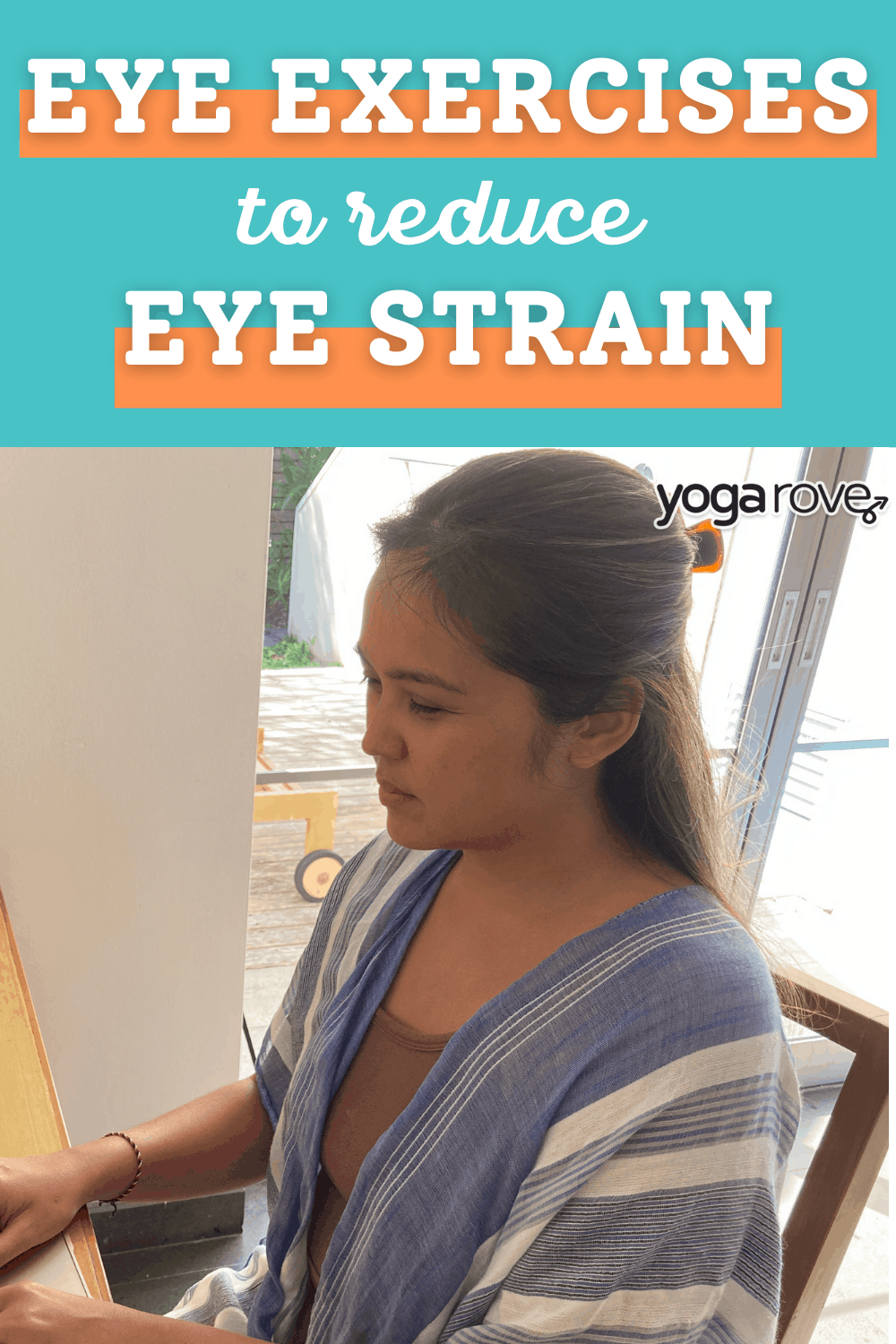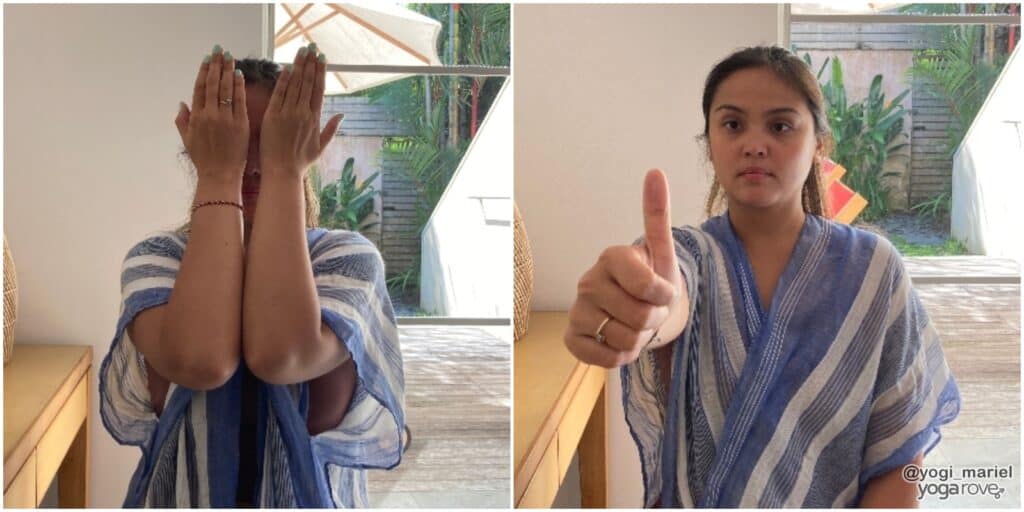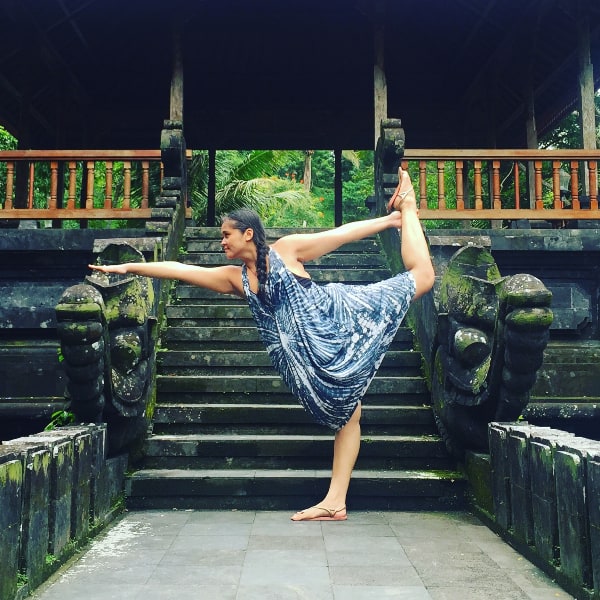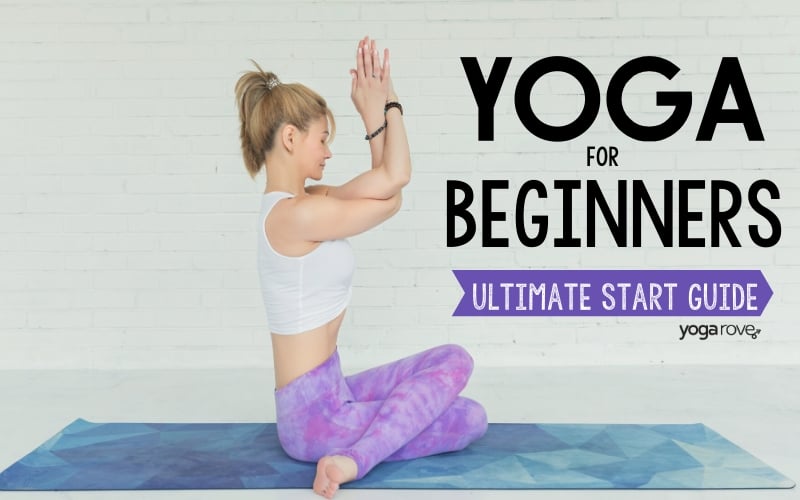This post may contain affiliate links. Please read our disclosure for more info.
They say that your eyes are the window to your soul. In addition to helping you to see and navigate the world, your eyes give you a unique perception of the world both physically and spiritually. Your eyes are extremely important, and it is equally important for you to take care of your eyes!

I’m sure as children, your parents told you not to sit too close to the TV and not to read in the dark because you would strain your eyes. As adults, we put a lot of strain on our eyes without necessarily realizing it. Many of us spend up to eight hours a day looking at screens, or maybe even more if you are scrolling through Facebook or Instagram into the wee hours of the night.
So what can you do to reduce eye strain? In addition to resting your eyes and giving them a break from your computer screen, there are many exercises that you can practice to rejuvenate your eyes. And believe it or not, there are even yoga exercises to practice that focus on reducing eye strain.
What is Eye Strain?
Eye straining occurs when you hold your eye muscles in one place for too long. Just like any other muscle in your body, you need to alternate between resting and exercising your eye muscles in order to keep them in a healthy, working order.
Some symptoms of eye strain include:
- Squinting
- Eye rubbing
- Watery eyes
- Headaches
- Sore eyes
- Tired eyes
- Itchy eyes
- Increased sensitivity to light
- Dry eyes
- Difficulty concentrating
- Blurred or double vision
Tips to Prevent Eye Strain
Eye strain can happen over a period of time or if you are doing a specific activity such as driving a long distance. If you would like to prevent eye strain altogether, get curious about your habits and how much rest you actually give your eyes.
Some tips to prevent eye strain include:
- Be aware of your computer or TV screen: Try not to have your computer or TV screen too close to your eyes. In addition, reduce as much glare on your screen by using Dark Mode when possible, or keeping the brightness at a comfortable range.
- Use lights: Whether you are reading a book or knitting, make sure that you have an ample amount of light. Darkness can cause you to strain your eyes more, so having a good source of light will allow for more comfort when reading or working.
- Wear your glasses or contacts: If you have been prescribed glasses or contacts, make sure that you wear them so that you avoid squinting your eyes.
- Exercise your eyes and keep them lubricated: Blink often and try yoga eye exercises to keep your eyes healthy and rested. You can also use eye drops if you tend to have dry eyes.
- Improve indoor air quality: If your room is too dry or doesn’t have enough circulation, consider a humidifier or a few plants to improve the air that your eyes are exposed to.
Benefits of Yoga for the Eyes
There are numerous eye exercises you can practice to help keep your eyes healthy. These eye exercises relax all the complex parts of our eyes, giving your eyes a much-needed reprieve from working so hard. While eye strain does not lead to any serious or lasting effects, reducing screen time and practicing the following exercises can help:
- Reduce strain
- Prevent headaches and migraines
- Prevent eye irritation
- Rest and relax your eyes
- Release stress and tension
- Keep your eyes healthy
Eye Exercises
You know that you can practice yoga for your body, but how about yoga for your eyes? Curious about the practice? The following exercises are designed to relieve your eyes of everyday strain.
Palming
This is a great exercise to practice if you need a break from your screen.

- Sit with your legs crossed in a chair.
- Keep your back straight and close your eyes.
- Rub your palms together for about 15 seconds, creating friction and warmth.
- Bring your palms to your eyes with your fingers pointing up
- Touch your eyes and then your forehead with the heels of your hands.
- Allow yourself to feel the warmth of your hands as you relax with your eyes closed.
Eye Rolling
Rolling your eyes can actually be beneficial! Try this exercise out to relieve any tiredness and tension.
- Sit tall and relax your breath and your eyes.
- Keep your head leveled with your chin tucking slightly into your chest to feel the back of your neck long.
- Roll your eyes up to look towards the sky or ceiling.
- Slowly rotate your eyes in a clockwise motion.
- While doing this, see how many things you can see through your peripheral vision.
- Practice this three times and then stop, relax your eyes and repeat in a counterclockwise circle.
Zooming
A few minutes of this exercise can be a great relief for your eye. Take a computer break and try Zooming out.
- Extend one arm out in front of you, giving yourself a thumbs up.
- Set your gaze on your thumb and slowly start to bring your thumb back towards your face until it is out of focus.
- Maintain eye contact with your thumb.
- Pause for a few seconds before slowly straightening your arm back out staying focused on your thumb.
- Practice 3-5 times.
Distant Gazing
Focusing on an object far away can exercise your eyes, especially if you are staring at our computer all day.
- Find a distant object to set your sight on.
- Focus on the object as intently as possible while keeping your eyes and face as relaxed as possible.
- As you take a deep breath in, reset your focus on a different distant object.
- Repeat this several times, shifting your gaze to things at varying distances.
Figure of Eight
Exercise your eyes by creating a figure eight with your hand.
- Sit in a comfortable seat on the floor.
- Extend your right arm straight out in front of you.
- Make a fist with a thumbs up.
- Draw a Figure 8 with your fist and keeping your head still, follow the Figure 8 with your right eye.
- Repeat with your left hand and left eye.
Drishti
Drishti is often practiced during your yoga class while you are in a yoga pose. To practice dristhi, set your gaze on an unmoving object or point in front of you. Focus all your attention on that spot and resist changing your line of vision. Here are a few Drishti points that you can practice:
- Nasagram Drishti: at the tip of your nose
- Ajna Chakra or Bhrumadhya Drishti: right in between your eyebrows
- Nabhi Chakra Drishti: at your navel
- Hastagram Drishti: on your hand
- Padayoragram Drishti: on your toes
- Parshva Drishti: to the right
- Parshva Drishti: to the left
- Angushthamadhyam Drishti: on your thumbs
- Urdhva or Antara Drishti: up to the sky
Trataka
This eye exercise can also be used as a meditation practice.
- Set up a quiet and dimly lit space.
- Light a candle two feet in front of you and sit in a comfortable seat.
- Set your gaze on the flame of the candle.
- Look directly at the middle part of the flame, right above the wick.
- Stare at the flame for as long as possible.
- Blink when necessary and allow your focus to be solely on the flame.
- Try practicing this meditation for 3 minutes, and stay for as long as you would like.
How Often Should You Practice Yoga for the Eyes?
You can practice yoga for the eyes every day! If you work at a computer all day, or if your job requires you to use your eyes for a long period of time, it’s a good idea to not only practice daily but a few times a day.
These eye exercises don’t take a lot of time, so all you need is a minute or two to reset your eyes and give them a little bit of a break. Every 20 minutes, look away from your computer and practice the exercise of your choice.
If you don’t strain your eyes regularly, you can make these eye exercises a part of your daily routine. Practice one or two when you wake up, or right before you go to bed. These exercises are extremely beneficial for your eye health and will help you to reduce eye strain.
Foods for Eye Health
Eating well not only keeps your body healthy, but it has a positive impact on your eye health as well. The most important nutrients to have in your diet include zinc, copper, vitamin C, vitamin E, and beta carotene omega-3 fatty acids, and lutein.
- Fish: Rich in Omega-3 fatty acids, fish is great to eat to keep your retina and back of your eye healthy. Try to eat tuna, salmon, trout, mackerel, sardines, anchovies, or herring a few days a week.
- Nuts: Walnuts, Brazil nuts, cashews, and peanuts are nuts that are also rich in omega-3 fatty acids, as well as Vitamin E. Nuts can help to protect your eyes from free radicals that may break down your eyes tissue. Grab a handful of nuts as a snack, or add them to your salad or smoothie.
- Seeds: They may look tiny, but seeds are rich in antioxidants, calcium, and omega-3 fatty acids. Add chia seeds, flax seeds, and hemp seeds to your diet to keep your eyes vibrant and clear.
- Citrus fruits: You already know that citrus fruits are rich in vitamin C, but did you know that this vitamin helps to combat cataracts or degeneration in your eyes? Have a grapefruit for breakfast or a glass of OJ to get more vitamin C into your diet.
- Leafy greens: Kale, spinach, and collard greens, for example, are rich in both vitamins C and E. Like citrus fruits, green, leafy greens help with degeneration of your eyes and combating cataracts.
- Carrots: Full of beta carotene, carrots can help to improve your vision and help you to see clearly, even in the darkness. Munch on some baby carrots as a snack, or add a few carrot pieces to your salad.
- Eggs: Egg yolk is full of vitamin A, lutein, and zinc, all of which are vital to eye health.
Eyes and Spirituality
The eye holds significant symbolic importance in many cultures, including yogic culture. In yoga, you often hear about the third eye which coincides with your 6th chakra. The third eye is located right between your eyebrows and is your command center. It correlates with your pituitary gland and the frontal cortex.

The third eye relates to:
- Vision and sight
- Intuition
- Imagination
- Insight
- Higher power and your higher self
In addition to keeping your two physical eyes healthy, it is also important to keep your third eye open and clear. If your 6th chakra or third eye is out of balance, you may experience:
- Headache
- Vision problems
- Difficulty imagining the future
- Insensitivity
- Skepticism and denial
- Poor dream recall
If your third eye is balanced you should experience:
- Good memory
- Good dream recall
- Self-awareness
There are many ways to balance out your third eye, including strengthening your relationship with yourself and your intuition. Although unseen, the third eye is an important energy center, and when it is in balance, you can feel more energized, stronger, and more self-aware. To balance your third eye you can practice the following yoga poses and practices:
- Child’s pose
- Meditation
- Corpse pose
- Chanting the sound of “ohm”
Keeping your eyes healthy both physically and spiritually will lead to a balanced, well-perceived opinion of the world. Not only will you be able to visually see things clearly, but you will be able to avoid tension headaches, tiredness, stress, and eye strain.
To keep your eyes healthy and bright, don’t forget to include your eyes in your daily beauty and self-care routine. Add some eye-healthy foods like carrots or fish to your diet, try some yoga for the eye exercise, and work on strengthening your third eye with meditation and your yoga practice. Your outer and inner eyes will be shining bright in no time!






